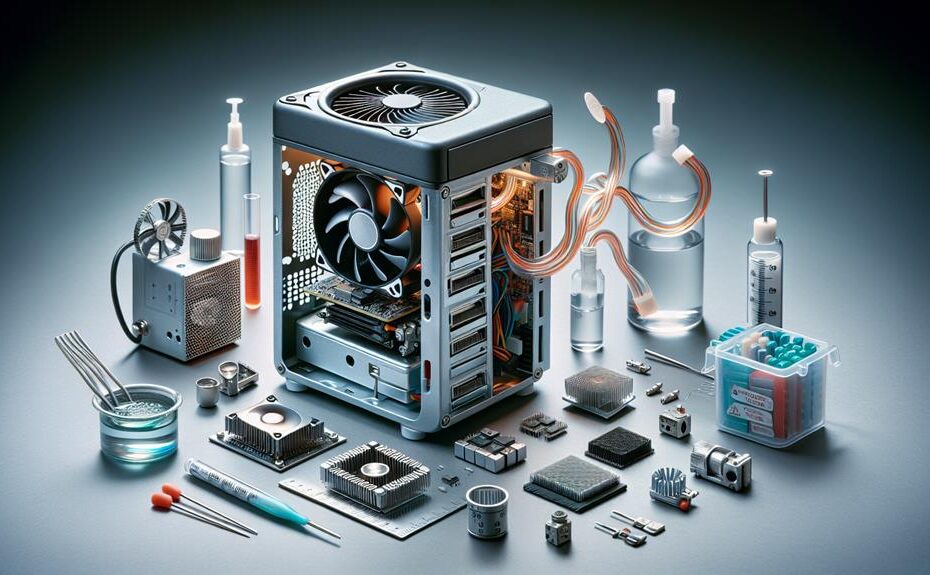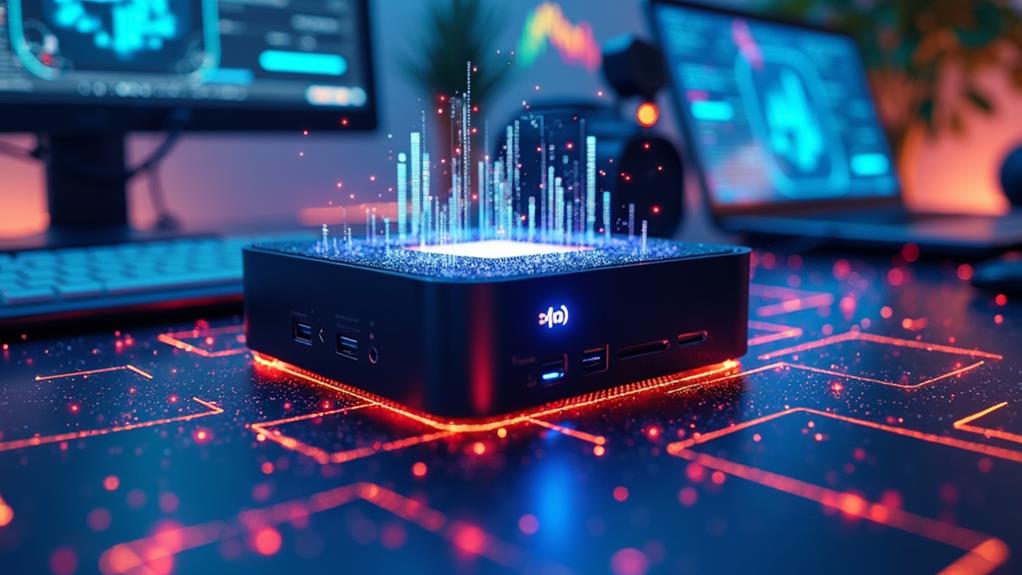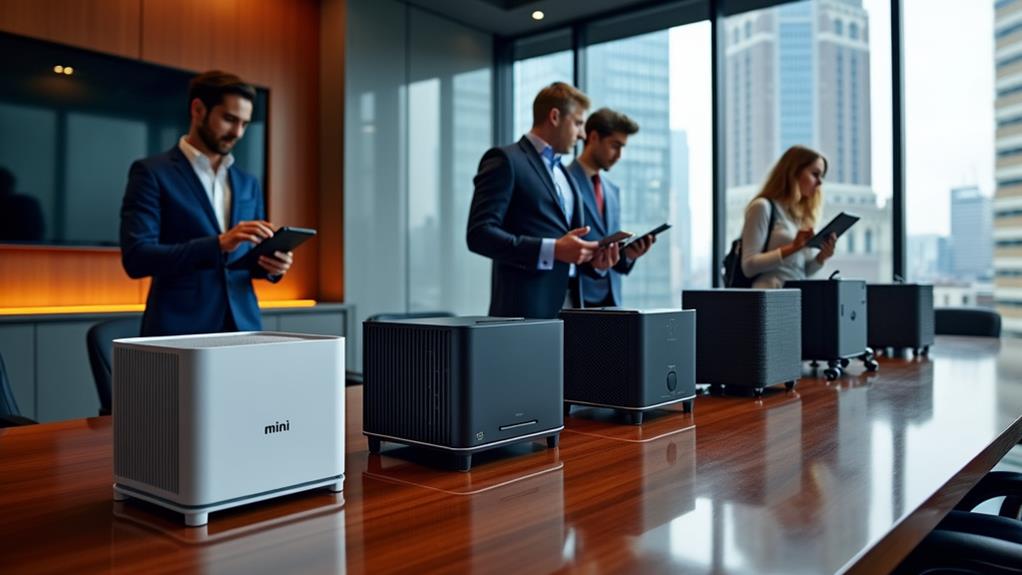



When choosing the right cooling solution for a mini PC, you might find yourself caught between the expedition of extreme performance and the indispensable necessity of silence. It's essential to balance these two seemingly opposing goals by considering the thermal load of your system, including the CPU and GPU, and evaluating the size constraints of your mini PC. Are you ready to find out how to select a cooling solution that won't only keep your system running smoothly but also provide you with the quiet, visually appealing operation you desire?
Key Takeaways
- Assess the thermal load of the system, including CPU, GPU, and other heat-generating components.
- Consider the importance of airflow management and ventilation within the compact case.
- Evaluate the tradeoff between cooling performance and noise level preferences.
- Compare air cooling and liquid cooling options based on installation complexity and maintenance.
- Ensure the chosen cooler fits within the case's available space and does not obstruct other components.
Understanding System Requirements
When selecting a cooling solution for your mini PC, understanding the system requirements is fundamental. The first step is to assess the thermal load of your system. This includes the CPU, GPU, and any other components that generate heat. For a Mini PC, the necessary cooling capacity is largely determined by these components. Compact designs, such as fanless and low-profile coolers, may be required to accommodate the smaller form factor.
Airflow management also plays a critical role. Adequate ventilation and strategic fan placement are indispensable for effective heat dissipation. Additionally, consider your noise level preferences. Do you prioritize silent operation or opt for better cooling performance? This will impact your cooler selection, as air coolers are generally noisier than liquid coolers.
Air Cooling Vs. Liquid Cooling
Both air cooling and liquid cooling methods can be viable options for your mini PC, but they cater to different needs and requirements, with air cooling offering a more straightforward and cost-effective approach and liquid cooling providing enhanced performance and noise reduction but at a greater cost and complexity.
Air coolers are generally more affordable and easier to maintain compared to liquid coolers. However, they often struggle to cool high-performance CPUs effectively within small form factor cases. They are suitable for users who value simplicity and cost savings, but their performance limitations can hinder overall system performance.
Liquid coolers, such as closed-loop and custom water cooling systems, offer superior cooling capabilities that make them ideal for confined spaces with restricted airflow. These systems are particularly beneficial for users who need excellent performance, low noise levels, and enhanced aesthetics. Nevertheless, they require more complex installation and maintenance compared to air coolers.
When choosing between air or liquid cooling, consider factors such as CPU heat output, mini PC form factor, case airflow, and your personal preferences for noise, aesthetics, and ease of use. By weighing these factors, you can select the most suitable cooling solution for your mini PC.
Passive Cooling Options
Passive cooling solutions for Mini PCs effectively eliminate the need for fans by relying on heatsinks and thermal conduction for silent operation. This method is particularly useful in environments where ambient temperatures are low and heat generation is minimal, such as for media centers or home office use. In these scenarios, passive cooling can provide stable performance without the noise and maintenance requirements associated with active cooling systems.
When selecting a passive cooling solution for your Mini PC, choose heatsinks made from materials like aluminum or copper. These materials provide high thermal conductivity, ensuring efficient heat transfer. Strategically placed ventilation holes and a thermally conductive chassis design are also essential elements in enabling effective passive cooling. This setup maximizes surface area and allows for ideal heat dissipation.
The main advantage of passive cooling is its reliability in harsh environments. Since it does not involve moving parts or fans, maintenance and dust cleaning are not a concern. However, it is important to note that passive cooling has limited cooling capacity and is not suitable for high-performance components that generate significant heat.
Case Compatibility and Layout
Your choice of case for your Mini PC greatly affects the cooling capabilities of your system, and you must confirm that the selected cooling solution fits and functions effectively within the case dimensions. This is especially important because Mini PC cases often come with severe size constraints, which can impact airflow and cooling performance. A suitable cooling solution must be carefully chosen to complement the case layout and offer efficient heat dissipation.
When evaluating case compatibility and layout, consider the following key points:
- Case Size and Shape: Compact cases necessitate low-profile coolers or custom water cooling solutions to fit comfortably and maintain airflow.
- Component Placement: Confirm the processor, vents, and other components are optimally positioned to allow for effective air circulation and cooling.
- Air Intake and Exhaust: Maximize airflow by strategically placing intake fans at the front and exhaust fans at the top or rear of the case.
- Cooling Solution Orientation: Consider the direction of air flow and how it relates to the cooler's installation and functionality.
- Compatibility with Cooling Type: Confirm the case is designed to accommodate your chosen cooling solution, whether it's air, liquid, or a hybrid setup.
Fan Configuration and Installation
When configuring fans for your Mini PC, strategic placement and installation of intake and exhaust fans are indispensable to create ideal airflow patterns. By installing fans securely with proper clearance around the housing, you guarantee unobstructed intake and exhaust, making the cooling system more effective.
The number and size of fans required depend on your system's thermal load. For higher-powered Mini PCs, more powerful cooling solutions are typically needed to keep temperatures in check. Select fans based on factors like noise level, airflow, and static pressure to strike a balance between cooling performance and acoustics.
Regular cleaning of fans and air vents is imperative to maintain optimal cooling performance. Dust buildup can impede airflow, so keeping these components clean will help ensure your system runs smoothly. By following these guidelines for fan configuration and installation, you can keep your Mini PC running cooler and more efficiently for a longer lifespan.
TDP and CPU Socket Considerations
As you move on to selecting a cooling solution for your Mini PC, it's essential to guarantee that it can handle the thermal design power (TDP) of your CPU and is compatible with the socket on your motherboard. This becomes crucial, as insufficient cooling can lead to overheating and damage to your hardware.
- TDP Compatibility: Confirm the chosen cooler is designed to handle your CPU's thermal design power (TDP) to maintain stable performance and temperatures.
- Socket Compatibility: Verify that the cooling solution is compatible with the specific socket on your motherboard to ensure proper installation and functioning.
- Size Constraints: Larger Coole…
Noise Level and Aesthetic Balances
For ideal performance and user experience, a balance must be struck between noise levels and the visual appeal of the cooling system in your Mini PC. When selecting a cooling solution, it is essential to consider both the noise your chosen system produces and how it fits with the aesthetic you desire. Quiet operation is often a priority in Mini PCs, so low-noise cooling options like fanless designs or high-quality fans are critical for minimizing acoustic disturbance. Additionally, some closed-loop liquid coolers offer customizable RGB lighting to enhance the visual appeal of your Mini PC.
To achieve this balance, you must weigh the tradeoffs between active and passive cooling solutions. Active cooling systems, such as case fans or CPU coolers, can provide better thermal management but may compromise on noise levels. On the other hand, passive cooling options like heatsinks and thermal pads can provide silent operation but may struggle to handle high-performance components effectively. By carefully evaluating your specific requirements, you can find a water cooler or air cooler that matches your desired noise profile and complements the overall design aesthetic of your system.
Maintenance and Longevity
Regular maintenance of your Mini PC's cooling solution, through cleaning and monitoring, can substantially extend its lifespan by preventing overheating and ensuring optimal thermal management. A key part of this is regular cleaning. Dust accumulation on fans, heatsinks, and other components can drastically reduce cooling efficiency. As a result, cleaning your Mini PC regularly helps maintain ideal airflow and cooling performance.
- Cleanliness is key: Regularly remove dust from the case and internal components, ensuring unobstructed airflow and heat dissipation.
- Monitor temperatures: Use software tools to monitor your Mini PC's temperature, allowing for prompt adjustments to prevent thermal issues.
- Increase cooling capacity: Upgrading the cooling solution, such as adding more heatsinks or fans, can greatly enhance thermal performance.
- Consider passive solutions: Passive cooling can be effective in certain conditions, particularly in applications where low noise levels are required.
- Case selection matters: Ensure that the chosen case has adequate space for air circulation and fan placement, which is vital for maintaining low temperatures and long-term reliability.
Budget and Overall Value Proposition
The budget and overall value proposition of a cooling solution for your mini PC depend on a delicate balance of performance, noise, maintenance, and cost considerations, which you must carefully weigh to safeguard ideal thermal management without breaking the bank. For instance, air coolers are generally more budget-friendly than liquid coolers, making them a cost-effective option for mini PCs. If you are concerned about noise levels, passive cooling through heatsinks can provide silent operation but may have restricted cooling capacity for high-performance mini PCs.
Closed-loop liquid coolers offer improved thermal performance compared to air coolers but require a higher initial investment. Custom water cooling systems provide maximum cooling flexibility but are more complex and expensive to implement in a mini PC. You need to make sure that you carefully analyze these factors to select the cooling solution that best fits your specific mini PC build and ensures optimal performance while staying within your budget.
Frequently Asked Questions
How Do You Cool a Mini Pc?
You cool a mini PC by selecting appropriate air cooling methods like fans and heat sink selection.
How Do I Choose Liquid Cooling for My Computer?
"Surprisingly, choosing liquid cooling for your computer isn't rocket science. You'll reap the benefits of improved heat dissipation and overclocking capabilities, but potential drawbacks like complexity and maintenance needs should be considered before diving in."
What Kind of Cooling System Do I Need for My Pc?
For your PC, consider the desktop environment requirements and power consumption considerations. Check if passive cooling like heatsinks works or if active cooling with fans or liquid solutions is needed to prevent thermal throttling.
What Liquid Should I Use to Cool My Pc?
When crafting your coolant cocktail, combine distilled water with an antifreeze coolant mixture to shield from corrosion, ensuring a precisely balanced blend that keeps your system chill.
Conclusion
'Your mini PC's performance relies on the perfect cooling solution. As you navigate the complexities of air and liquid cooling, the right choice will mean the difference between heat and efficiency. Stay tuned to uncover the key considerations that will reveal your mini PC's full potential.'
Disclosure: As an Amazon Associate, I earn from qualifying purchases.







